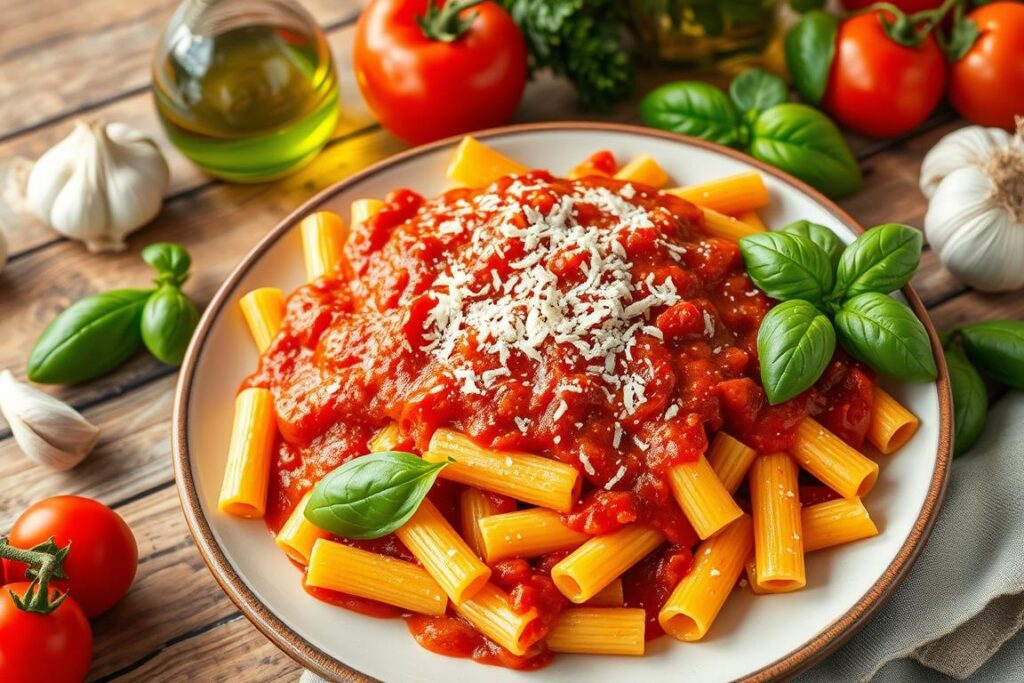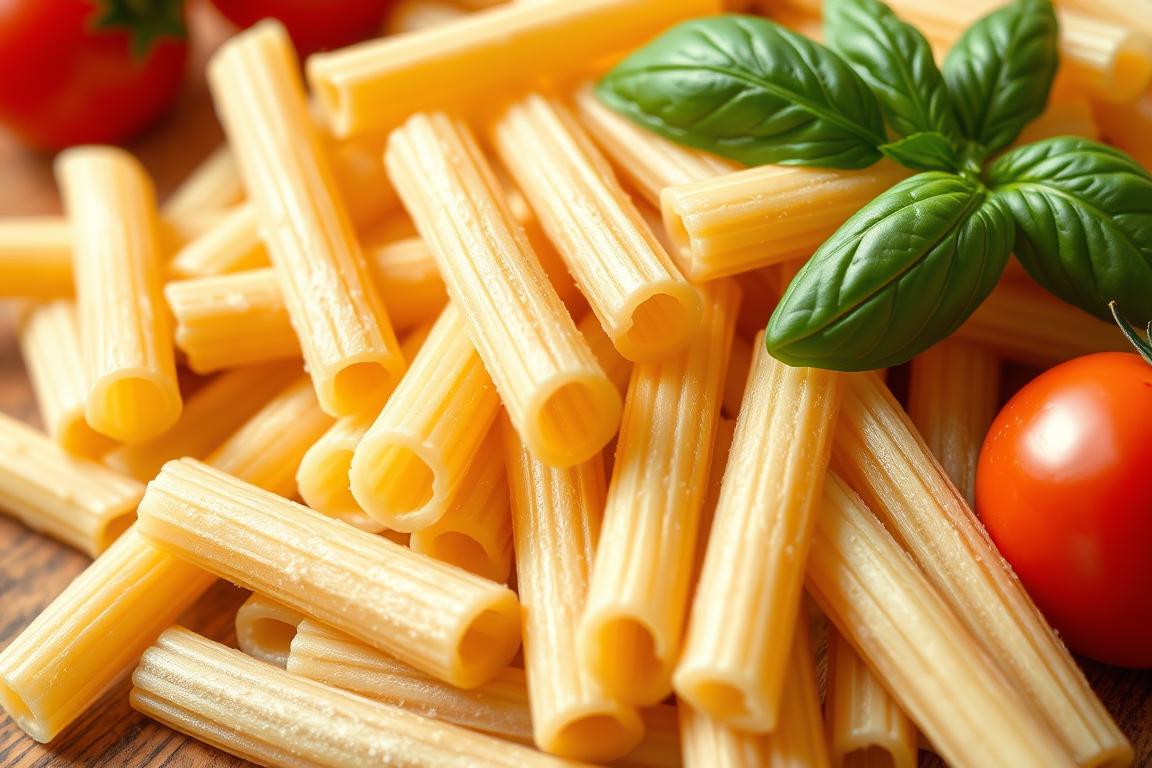What if the shape of your pasta could make a meal amazing? Rigatoni’s shape is not just hearty but also great at holding flavor. This makes many ask, why is rigatoni the best pasta?
Its thick, ridged shape makes it a favorite in Italian cuisine. It’s loved for its versatility and how well it takes different sauces.
In Italian-American homes, rigatoni is more than dinner; it’s comfort and tradition. It’s often found in both everyday meals and fancy dishes. This article will look at what makes rigatoni special, its cultural importance, and its role in cooking. To learn more about this dish, check out rigatoni’s culinary journey.
Key Takeaways
- Rigatoni has a unique shape that makes it great at holding sauce and flavor.
- This pasta is a cultural icon in Italian and Italian-American food.
- Its thickness gives a satisfying bite and keeps sauces warm.
- Rigatoni is versatile, fitting for many dishes, from simple to fancy.
- Many think rigatoni is perfect with rich and creamy sauces.
The Unique Characteristics of Rigatoni
Rigatoni stands out among other pasta types with its special traits. These features make it versatile in many dishes, adding to Italian cuisine’s charm. Knowing these can make cooking with it more exciting.
Shape and Size
Rigatoni’s shape is what makes it unique. It looks like large, hollow tubes, about two inches long. This shape helps it hold onto sauces and ingredients well, making every bite enjoyable. It’s a favorite in kitchens everywhere because of its versatility.
The classic design makes it easy to twirl on a fork and gives a great texture. This makes eating it a pleasure.
Ridged Surface Benefits
Rigatoni also has a ridged surface. These ridges are key to its sauce-holding ability. They help the pasta stick to rich sauces like bolognese or meat sauces. This ensures every bite is full of flavor.
This shape and texture combo means each piece gets a good coating of sauce. It’s perfect for hearty meals. For more about rigatoni’s benefits, check out this helpful article.
Rigatoni and Its Popularity in Italian Cuisine
Rigatoni is a big deal in Italian food, coming from southern Italy. Its unique ridges and tube shape are perfect for holding onto rich sauces. This makes it a key player in many traditional dishes.
Origin and History
Rigatoni started in the 19th century and quickly gained fans in places like Lazio and Campania. Its name comes from “rigare,” meaning to scratch or line, due to its ridged surface. These ridges help hold sauces well. Over time, rigatoni became a favorite in Italy and beyond.
Rigatoni in Traditional Italian Dishes
Rigatoni is a star in many classic Italian recipes. Some top recipes include:
- Rigatoni alla Vodka – a creamy, tangy sauce that complements the pasta perfectly.
- Baked Rigatoni – often made with hearty meats, cheese, and mixed vegetables, baked to achieve a satisfying crust.
- Amatriciana – a classic Roman sauce made with guanciale, tomatoes, and Pecorino Romano cheese.
These dishes show how rigatoni’s strong structure can carry rich sauces. It’s a top pick for family meals and special events. Its versatility makes it a key part of Italian food.

Why is rigatoni the best pasta?
Rigatoni is a top choice in the world of pasta for many reasons. Its unique cooking properties and flavor enhancement make it stand out. These features make it the go-to pasta for many dishes.
The Sauce-to-Pasta Ratio
Rigatoni’s large, hollow shape is key to its success. It lets sauce stick to both the outside and inside, making every bite flavorful. This makes rigatoni different from other pastas, offering a great mix of taste and texture.
Heat Retention and Cooking Consistency
Rigatoni keeps heat well, ensuring consistent cooking. It’s easy to cook and forgiving, making it perfect for all cooks. This makes rigatoni a top pick for those looking for both ease and great taste.
Whether you’re making a quick dinner or a fancy meal, rigatoni’s benefits can take your dish to the next level. Its excellent sauce-to-pasta ratio and heat retention are key. For more on the differences between pasta types, check out this guide on penne vs. rigatoni.
How Rigatoni Complements Sauces
Rigatoni is amazing with thick sauces, showing off its special qualities. Its ridges and hollow center grab onto rich flavors. This makes it a top pick for many dishes.
Thick Sauces and Rich Flavors
Rigatoni is great with thick sauces like marinara, bolognese, or creamy cheese. These sauces stick well to its ridges, making each bite full of flavor. It’s a treat because it takes in the sauce so well.
Pairing Rigatoni with Ingredients
Rigatoni works well with many ingredients, offering endless taste options. Adding Italian sausage or veggies like mushrooms or bell peppers boosts the flavor. A good pasta recipe lets cooks try new things and make tasty meals for any event.

Rigatoni Versatility in Pasta Recipes
Rigatoni is great for many pasta recipes, fitting both simple and fancy meals. It’s perfect for creative cooks and meets the needs of family dinners. This pasta is adaptable and versatile, making it a favorite in kitchens everywhere.
From Simple to Gourmet
For a quick, tasty meal, rigatoni is ideal. Just sauté it with olive oil and garlic for a delicious dish. Or, for a fancy meal, try rigatoni al forno for a touch of elegance. It lets chefs show off their skills.
Family-Friendly Meal Options
Rigatoni is a hit with families because it’s filling and easy for kids to eat. It’s great for busy weeknights. You can make it with a rich meat sauce or bake it with cheese and veggies. It’s a go-to for many families.
For more tasty ideas and to learn more about pasta, check out this link.
The Al Dente Experience with Rigatoni
Getting the rigatoni to the perfect al dente is key to a great pasta dish. This method keeps the pasta firm and slightly chewy, making the taste better. When done right, rigatoni offers a fulfilling bite, especially with tasty sauces.
Perfect Cooking Techniques
Cooking rigatoni to the right point needs careful attention. It usually takes 15 minutes, but this can change with different brands and sizes. Here are the best ways to cook it:
- Use a large pot of boiling salted water.
- Check the pasta often, tasting a piece to find that perfect al dente moment.
- Drain the pasta quickly, saving some water to adjust the sauce if needed.
Texture and Taste
When rigatoni is cooked al dente, it pairs well with many sauces. Its shape lets the sauce cling to it, blending flavors perfectly. A dish with great rigatoni texture contrasts well with rich sauces, making each bite full of flavor. The right cooking methods highlight the pasta and sauce’s flavors and textures.
Comparison with Other Pasta Types
Looking at rigatoni compared to penne and macaroni shows their unique qualities. Each shape affects how well they work with sauces and ingredients.
Rigatoni vs. Penne and Macaroni
Rigatoni stands out in the pasta world. Penne has angled edges for a nice chew but can’t hold thick sauces well. Macaroni is loved but doesn’t have the structure for rich flavors. Rigatoni’s size and ridges make it great at holding sauces, making it a top choice for a satisfying meal.
Why Rigatoni Holds the Edge
Rigatoni’s shape, size, and texture make it better than other pastas. It’s great at keeping sauce, turning a simple dish into something special. Its ridges and hollow inside hold more sauce than penne and macaroni. This means every bite is full of flavor, making rigatoni a favorite for pasta fans.
| Pasta Type | Size | Texture | Sauce Retention |
|---|---|---|---|
| Rigatoni | Large | Ridged | Excellent |
| Penne | Medium | Smooth | Good |
| Macaroni | Small | Smooth | Poor |
Cooking Rigatoni to Perfection
Learning to cook rigatoni right means getting the timing and techniques just right. Start by boiling a big pot of salted water. The salt boosts the flavor and makes the dish more enjoyable.
Timing and Techniques
Cooking rigatoni usually takes 10 to 12 minutes. Check it often to see if it’s just right. When it’s done, drain it fast and mix it with sauce. This makes sure the pasta is well coated and its ridges stand out.
Common Mistakes to Avoid
Some mistakes can ruin your rigatoni. Overcooking makes it mushy and loses its texture. And if you don’t mix it with sauce right away, it might taste bland. Paying attention to these tips helps your rigatoni turn out great every time, making meals more enjoyable.


